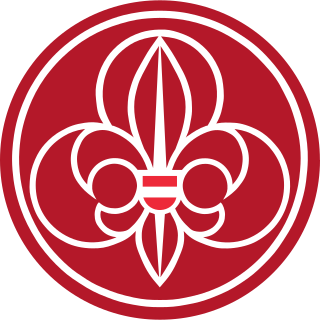
The White Rose was a non-violent, intellectual resistance group in Nazi Germany which was led by five students at the University of Munich: Willi Graf, Kurt Huber, Christoph Probst, Alexander Schmorell, Hans Scholl and Sophie Scholl. The group conducted an anonymous leaflet and graffiti campaign that called for active opposition to the Nazi regime. Their activities started in Munich on 27 June 1942; they ended with the arrest of the core group by the Gestapo on 18 February 1943. They, as well as other members and supporters of the group who carried on distributing the pamphlets, faced show trials by the Nazi People's Court ; many of them were sentenced to death or imprisonment.

The World Organization of the Scout Movement is the largest international Scouting organization. WOSM has 172 members. These members are recognized national Scout organizations, which collectively have around 43 million participants. WOSM was established in 1922, and has its operational headquarters at Kuala Lumpur, Malaysia and its legal seat in Geneva, Switzerland. It is the counterpart of the World Association of Girl Guides and Girl Scouts (WAGGGS).

The Hitler Youth was the youth organisation of the Nazi Party in Germany. Its origins date back to 1922 and it received the name Hitler-Jugend, Bund deutscher Arbeiterjugend in July 1926. From 1936 until 1945, it was the sole official boys' youth organisation in Germany and it was partially a paramilitary organisation. It was composed of the Hitler Youth proper for male youths aged 14 to 18, and the German Youngsters in the Hitler Youth for younger boys aged 10 to 14.

Hans Fritz Scholl was, along with Alexander Schmorell, one of the two founding members of the White Rose resistance movement in Nazi Germany. The principal author of the resistance movement's literature, he was found guilty of high treason for distributing anti-Nazi material and was executed by the Nazi regime in 1943 during World War II.

Wandervogel is the name adopted by a popular movement of German youth groups from 1896 to 1933, who protested against industrialization by going to hike in the country and commune with nature in the woods. Drawing influence from medieval wandering scholars, their ethos was to revive old Teutonic values, with a strong emphasis on German nationalism. According to historians, a major contribution of the Wandervögel was the revival of folk songs in wider German society.
The German Youth Movement is a collective term for a cultural and educational movement that started in 1896. It consists of numerous associations of young people that focus on outdoor activities. The movement included German Scouting and the Wandervogel. By 1938, 8 million children had joined associations that identified with the movement.

Pfadfinder und Pfadfinderinnen Österreichs is the largest Scouting and Guiding organization in Austria and the only one approved by World Association of Girl Guides and Girl Scouts (WAGGGS) and the World Organization of the Scout Movement (WOSM). The association claims more than 300 troops with more than 85,000 Scouts nationwide. WOSM and WAGGGS give quite smaller membership values for the PPÖ: 9,503 Scouts and 10,508 Guides.
A Zionist youth movement is an organization formed for Jewish children and adolescents for educational, social, and ideological development, including a belief in Jewish nationalism as represented in the State of Israel. Youth leaders in modern youth movements use informal education approaches to educate toward the movement's ideological goals.

The Deutsches Jungvolk in der Hitlerjugend was the separate section for boys aged 10 to 13 of the Hitler Youth organisation in Nazi Germany. Through a programme of outdoor activities, parades and sports, it aimed to indoctrinate its young members in the tenets of Nazi ideology. Membership became fully compulsory for eligible boys in 1939. By the end of World War II, some had become child soldiers. After the end of the war in 1945, both the Deutsches Jungvolk and its parent organization, the Hitler Youth, ceased to exist.

The Scout movement in Germany consists of about 150 different associations and federations with about 260,000 Scouts and Guides.

The Swiss Guide and Scout Movement (SGSM) is the national Scouting and Guiding association of Switzerland formed in 1987. Scouting was founded in Switzerland in 1912 and was among the charter members of the World Organization of the Scout Movement in 1922 and among the founding members of the World Association of Girl Guides and Girl Scouts in 1928. The SGSM has more than 50,500 members in about 550 local groups.

The Deutsche Pfadfinderschaft Sankt Georg is the largest of Germany's many Scouting organizations. The Catholic association has about 95,000 members of both genders. Via the Ring deutscher Pfadfinderverbände it is a member of the World Organization of the Scout Movement.

Böttingen is a municipality in the district of Tuttlingen in Baden-Württemberg in Germany. In recent decades it has developed from an agricultural village to an advanced industrial community.

Eberhard Koebel also Eberhard Köbel, called tusk, i.e., "the German" in the language of the Sámi people he traveled among, was a German youth leader, writer, and publisher.

The Sturmtrupp-Pfadfinder was a Scout association in Germany active from 1926 to 1934. The association never had more than 500 members. It was the first Scout association in Germany to admit boys and girls. It was interdenominational and politically neutral.
Ludwigstein Castle is a 15th-century castle overlooking the river Werra and surrounded by woodland. It stands southwest of the town of Witzenhausen in North Hesse. Founded in 1415 the castle's buildings today were built in the 16th and 20th centuries. It was allowed to go to ruin in the late 19th century.

The Deutsche Freischar – Bund der Wandervögel und Pfadfinder (DF) is a German youth organization. Originating from the merger of several small Wandervogel and Scouting groups, it was one of the largest and most important associations of the Bündische Jugend of the Weimar Republic besides the Deutscher Pfadfinderbund and Reichsschaft Deutscher Pfadfinder.

The Evangelical-Lutheran Church in Württemberg is a Lutheran member church of the Evangelical Church in Germany in the German former state of Württemberg, now part of the state of Baden-Württemberg.

The Deutscher Pfadfinderbund (DPB) was the first German Scouting association, and the forerunner of the Deutscher Pfadfinderbund (1945). It existed from 1911 until 1933, when it was disbanded by the National Socialists.

A Jugendburg, sometimes referred to in English as a youth castle, is a mediaeval castle in German-speaking countries that was converted during the 20th century into a public community centre or educational facility for young people. The sponsors of the original youth castles came mainly from the Wandervogel and Pfadfinder movement, or were at least linked to the youth movement.

















